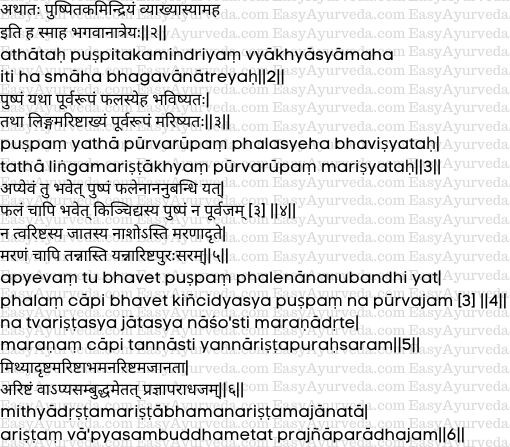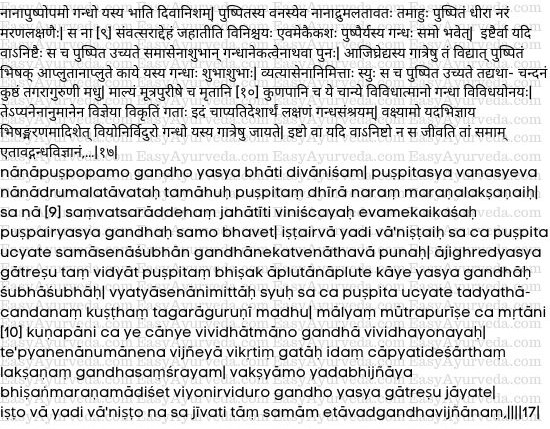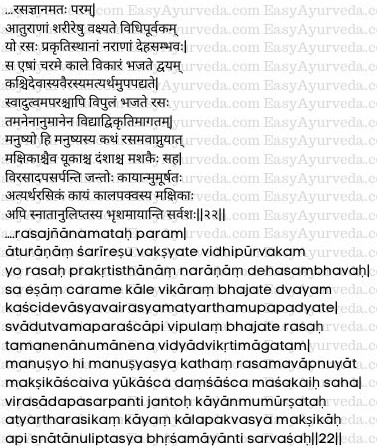Charaka Indriya Sthana 2nd Chapter Pushpitakam indriyam
2nd chapter of Charaka Indriya sthana deals about symptoms of imminent death of the individual (Puspita) relating to the taste and smell in his body The chapter name is Pushpitakam Indriyam.
Read – Arishta Lakshanas – Ominous Signs And Symptoms Indicating Bad Prognosis

We shall now expound the chapter on “The exhalation of odor indicative of imminent Death”. Thus said Lord Atreya [1-2]

A simile
Just like flowers appear before the production of fruits, the fatal symptoms and signs appear before the death of a person as premonitory symptoms. [3]
All flowers do not eventually shape up into fruits into future. Certain flowers may be devoid of fruition. Similarly sometimes even fruits may be produced without any flowers i.e. there are no flowers before the fruits are produced. But once the fatal symptoms appear they wouldn’t disappear without having caused death. This means to tell that once these symptoms are produced they will definitely cause death. Conversely there isn’t any death without being preceded by its premonitory symptoms i.e. fatal signs and symptoms. [4-5]
Inability to comprehend signs of imminent death because of Intellectual blasphemy
An ignorant person sometimes wrongly views pseudo symptoms as real premonitory symptoms. Sometimes he does not even recognize the real premonitory symptoms as such. All this is the result of intellectual blasphemy. [6]
Read – Bad Prognosis Based On Premonitory Symptoms Of Disease – Purvarupiya Arishta

With a view to explaining the several premonitory symptoms preceding death as indicative of its imminence, we now illustrate the various persons with such manifestations. [7]
Characteristic smell of moribund persons

A person whose body emits fragrance similar to that of many flowers, as if the smell is coming from a garden in which many trees and creepers bearing fragrant flowers are grown, is called as pushpita i.e. the person’s body is flowering / flowered. This is because these are the symptoms of impending death (fatal signs and symptoms). Thus, such manifestations are indicative of imminent death. Any person presenting with such signs and symptoms is sure to die within a span of one year.
Read – Bad Prognosis Based On Smell, Touch, Taste, Colour And Voice
A body of the person which emits the fragrance of only one flower be it fragrant or foul smelling is also considered as pushpita. If the body is of a person is emitting many unpleasant odours at a time or even if foul smell of different flowers having unpleasant smell are emitted at different times which can be perceived by the organ of smell i.e. nose, the person will be regarded as being pushpita.
Even if the smell of the body resembles the fragrance of different pleasant and unpleasant flowers, one by one, a person with such manifestation is also regarded as “Puspita”. Here variety of unpleasant odours are emitted simultaneously from the body of the patient which indicates fatal signs or symptoms of impending death. If the body emits unpleasant odour even when covered with fragrant unguents and pleasant odour when no unguents are applied, if the unpleasant unguents emit pleasant odor and pleasant odours emit unpleasant odour or when pleasant and unpleasant odours are emitted alternatively from the body of the same person, he is known to be pushpita.
Odour of Sandalwood, Kustha (Saussurea lappa), Tagara (Valeriana wallichi), Aguru (Aquilaria agallocha), honey and garland are pleasant. Odour of urine, faeces and dead bodies (of human beings or animals) are unpleasant. According to this analogy, odour from similar other sources are also to be considered as premonitory symptoms by inference. We shall further explain as examples, the premonitory symptoms based on olfactory perception in order to facilitate general appreciation of such symptoms by knowing which a physician can predict imminent death.
Ex – the individual whose body emits pleasant or unpleasant smell continuously without any appreciable cause cannot survive for more than a year.
This is all about pre-monitory symptoms based on the smell of the body of the individual. [8-17]
Read – Anosmia: Ayurvedic Treatment And Home Remedies
Taste of moribund persons

Read – Prognosis Signs Based On The Messenger – Doota Adhishtita Arishta
Now we shall appropriately describe the signs of imminent death, as indicated by the taste in the patient’s body. The normal bodily taste of human beings undergoes two types of modification on the event of death. This modification may be either in the form of appearance of extremely abnormal taste in the mouth or in the form of extreme sweetness. Morbid conditions of taste can only be inferred. One cannot otherwise have a direct perception of such conditions (one cannot lick or taste the body of the patient to access the taste of the body).
In the case of the first types of morbidity, flies, lice, wasps and mosquitoes get away from the body of a moribund person having an abnormal taste. On the other, hand, flies repeatedly surround the body of a moribund person having extremely sweet taste of the body even after he has taken bath or has applied unguents. [17-22]
Read – Acharya Charaka – Work, Samhita, Legacy, Chapters, Description

To sum up- Symptoms of imminent death of the individual relating to the taste and smell in his body are described here in general. Such symptoms lead to death of the individual. [23] Thus ends the second chapter on the “Exhalation of Odour Indicative of Imminent Death” of Indriya section of Agnivesha’s work as redacted by Charaka.









